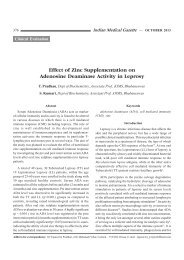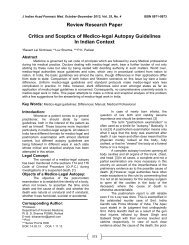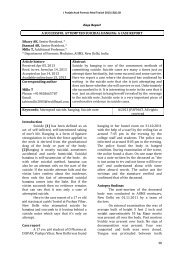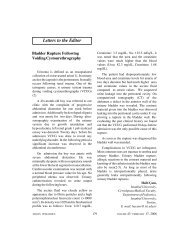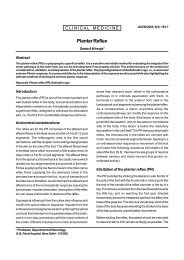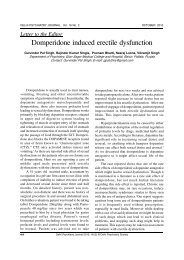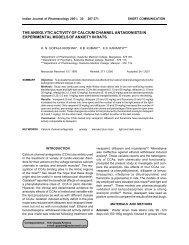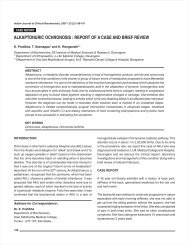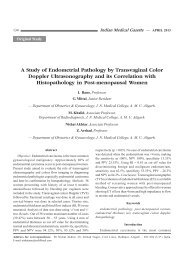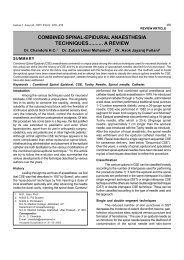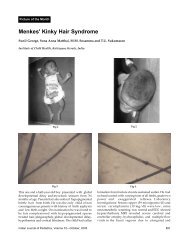Ovarian germ cell tumor : a 3 years study - medIND
Ovarian germ cell tumor : a 3 years study - medIND
Ovarian germ cell tumor : a 3 years study - medIND
You also want an ePaper? Increase the reach of your titles
YUMPU automatically turns print PDFs into web optimized ePapers that Google loves.
J Obstet Gynecol India Vol. 55, No. 1 : January/February 2005 Pg 61-63<br />
ORIGINAL ARTICLE<br />
The Journal of<br />
Obstetrics and Gynecology<br />
of India<br />
<strong>Ovarian</strong> <strong>germ</strong> <strong>cell</strong> <strong>tumor</strong> : a 3 <strong>years</strong> <strong>study</strong><br />
Jadhav Balaji Jagannath, Shinde Mangala Ashok<br />
Department of Obstetrics and Gynecology, Swami Ramanand Teerth Rural Medical College and Hospital,<br />
Ambajogai – 431517<br />
OBJECTIVE(S) : To <strong>study</strong> the various types of ovarian <strong>germ</strong> <strong>cell</strong> <strong>tumor</strong>s (OGCT), their clinical presentation and management.<br />
METHOD(S) : Eleven patients of ovarian <strong>germ</strong> <strong>cell</strong> <strong>tumor</strong>s admitted during the period of 1 st October 2000 to 30 th September 2003 were<br />
clinically studied along with their sonography, laparotomy findings and histopathology.<br />
RESULTS : Teratomas were observed in 63.63% (n=7) of cases, followed by malignant <strong>germ</strong> <strong>cell</strong> <strong>tumor</strong>s in 27% (n=3) and special <strong>tumor</strong><br />
i.e. struma ovarii in 9.0% of cases. These <strong>tumor</strong>s occurred in patients aged 13 to 50 <strong>years</strong>, the peak incidence being at 18-30 <strong>years</strong>.<br />
CONCLUSION(S) : <strong>Ovarian</strong> <strong>germ</strong> <strong>cell</strong> <strong>tumor</strong>s are rare and mostly seen in young women.Timely surgery and chemotherapy in malignant<br />
<strong>tumor</strong>s save the life of the women.<br />
Key words : ovarian <strong>germ</strong> <strong>cell</strong> <strong>tumor</strong>s, dermoid cyst, malignant <strong>germ</strong> <strong>cell</strong> <strong>tumor</strong>s, staging laparotomy.<br />
Introduction<br />
<strong>Ovarian</strong> <strong>germ</strong> <strong>cell</strong> <strong>tumor</strong>s are uncommon <strong>tumor</strong>s occurring<br />
predominately in children and young women. Malignant <strong>germ</strong><br />
<strong>cell</strong> <strong>tumor</strong>s, account for 2-5% of all ovarian malignancies.<br />
They are rapidly growing and may attain a very large size,<br />
and are highly responsive to timely treatment. In young<br />
patients, surgery should be conservative even in the presence<br />
of extra-ovarian disease as these <strong>tumor</strong>s are often curable<br />
with chemotherapy. Dermoid cyst is more common in young<br />
women but occasionally can be encountered at the extremes<br />
of ages.<br />
Material and Methods<br />
Eighty-one patients of ovarian <strong>tumor</strong>s were admitted in our<br />
gynecology ward from 1st October 2000 to 30th September<br />
2003. There were 11 cases of ovarian <strong>germ</strong> <strong>cell</strong> <strong>tumor</strong>s during<br />
this period. Their histories, physical findings, investigations<br />
including hematological profile, x-ray chest, abdominal and<br />
Paper received on 10/05/2004 ; accepted on 016/12/2004<br />
Correspondence :<br />
Dr. Jadhav Balaji Jagannath<br />
4- Shindhudurga, Medical College Quarters,<br />
Ambajogai - 431517<br />
Tel. (R) 02446 249847 (O) 02446 247060<br />
pelvic sonography, and pathological reports were scrutinized<br />
with the analysis of age, parity and nature of the <strong>tumor</strong>. All<br />
patients had laparotomy and staging laparotomy was carried<br />
out for malignant <strong>tumor</strong>s. Further management was decided<br />
according to the histopathology report.<br />
Results<br />
Out of the 81 ovarian <strong>tumor</strong>s, 11 (13.58%) were diagnosed<br />
as <strong>germ</strong> <strong>cell</strong> <strong>tumor</strong>s. The age of patients with <strong>germ</strong> <strong>cell</strong> <strong>tumor</strong>s<br />
varied from 13 to 50 <strong>years</strong> with the mean of 29 <strong>years</strong>. Six<br />
(54.54%) of the patients were para 3 or above while 3 (27.3%)<br />
were nulliparous.<br />
Benign cystic teratoma was observed in 63.63% of the cases<br />
followed by malignant <strong>germ</strong> <strong>cell</strong> <strong>tumor</strong>s in 27.27%. One case<br />
(9.09%) struma ovarii was seen.<br />
Management of benign ovarian teratoma<br />
Three cases of twisted ovarian cyst had emergency<br />
laparotomy, and cut section of the <strong>tumor</strong>s revealed dermoid<br />
cysts. Two cases above 40 <strong>years</strong> of age underwent total<br />
abdominal hysterectomy with bilateral salpingo-hysterectomy<br />
(TAH and BSO). Five cases had unilateral salpingooophorectomy.<br />
There was a single case of struma ovarii.<br />
She was a 50 year old, postmenopausal woman who had<br />
61
Jadhav Balaji Jagannath et al<br />
Table 1 : Management of benign ovarian teratoma<br />
Case Age Parity Diagnosis Management HPE<br />
No. (yrs)<br />
1 45 P 4<br />
Twisted TAH with BSO Dermoid cyst<br />
ovarian <strong>tumor</strong> (one twist) Tubes, Endocervix., Ectocervix.,<br />
normal histology<br />
2 30 P 4<br />
<strong>Ovarian</strong> cyst USO Dermoid.<br />
3 18 P 0<br />
Twisted ovarian <strong>tumor</strong> USO (3 twists) Dermoid.<br />
Chronic salpingitis<br />
4 30 P 3<br />
<strong>Ovarian</strong> <strong>tumor</strong> USO Dermoid.<br />
Normal tubal histology<br />
5 22 P 1<br />
Twisted ovarian <strong>tumor</strong> USO (2 twists) Dermoid.<br />
6 35 P 3<br />
<strong>Ovarian</strong> <strong>tumor</strong> USO Dermoid.<br />
7 40 P 3<br />
<strong>Ovarian</strong> <strong>tumor</strong> TAH with BSO Dermoid<br />
Endometrial-hyperplasia<br />
Myometial denomyosis.<br />
8 50 P 8<br />
<strong>Ovarian</strong> <strong>tumor</strong> TAH with BSO Struma ovarii.<br />
Abdominal pain<br />
Endometrium –Normal<br />
Ecto- and Endocervix –<br />
normal histology.<br />
TAH = Total abdominal hysterectomy, BSO = Bilateral salpingo-oophorectomy,<br />
USO = Unilateral salpingo-oophorectomy<br />
Table 2 : Management of malignant ovarian <strong>germ</strong> <strong>cell</strong> <strong>tumor</strong>s<br />
Case Age Parity Presentation & Management HPE<br />
No. (year) diagnosis<br />
1 18 P 0<br />
Pain with rapidly Laparotomy with Dys<strong>germ</strong>inoma.<br />
increasing abdominal USO (Rt) with Secondary deposits<br />
mass. omental biopsy. in omentum.<br />
Fever.<br />
Chemotherapy<br />
MOT.<br />
completed.<br />
2 22 P 2<br />
Amenorrhoea. Laparotomy with Dys<strong>germ</strong>inoma.<br />
5 months hysterotomy Deposits in<br />
Pain with rapidly followed by TAH omentum and paragrowing<br />
abdominal with BSO with aortic lymph node<br />
mass. Omental biopsy .<br />
G3 with MOT.<br />
Lost to follow up.<br />
3 13 P 0<br />
Pain in abdomen with Laparotomy with Immature teratoma .<br />
rapidly growing USO with No deposits in<br />
abdominal mass. Omental biopsy . omentum..<br />
Urinary retention. Lost to follow up .<br />
Fever .<br />
MOT.<br />
TAH = Total abdominal hysterectomy, BSO = Bilateral salpingo-oophorectomy,<br />
USO = Unilateral salpingo-oophorectomy, MOT = Malignant ovarian <strong>tumor</strong>.<br />
62
<strong>Ovarian</strong> <strong>germ</strong> <strong>cell</strong> <strong>tumor</strong><br />
come with abdominal pain. On examination, pelvic mass was<br />
discovered without any signs of twisting. Dilatation and<br />
curettage showed scanty endometrium. On laparotomy there<br />
was right sided ovarian <strong>tumor</strong> for which TAH and BSO was<br />
performed. The contralateral ovary showed normal histology<br />
(Table 1).<br />
Management of malignant ovarian <strong>germ</strong> <strong>cell</strong> <strong>tumor</strong>s<br />
(Table 2).<br />
Case 1 : An 18 year young girl came with a very large, rapidly<br />
growing ovarian <strong>tumor</strong> which was noticed 15 days back. At<br />
laparotomy the <strong>tumor</strong> was seen extending upto right<br />
hyochondriac region. Therefore ipsilataral salpingooophorectomy<br />
with omental biopsy was performed.<br />
Histopathology revealed dys<strong>germ</strong>inoma. She has completed<br />
6 cycles of chemotherapy and is doing well.<br />
Case 2 : A gravida 2, para 1 came with amenorrhea of 5<br />
months and abdominal distension. She was vary cachexic.<br />
At laparotomy, she had 18-20 weeks of pregnancy and right<br />
sided huge ovarian mass filling the abdomen. Hysterotomy<br />
was performed first and then removal of the <strong>tumor</strong> tried. But<br />
the uterus was obstructing removal of the <strong>tumor</strong> in toto.<br />
Therefore hysterectomy was performed and only thereafter<br />
the <strong>tumor</strong> could be removed. Omental biopsy was taken and<br />
para-aortic lymph node removed. Histopathology revealed<br />
dys<strong>germ</strong>inoma with deposits is the omentum and the lymph<br />
node. She was advised postoperative chemotherapy but is<br />
lost to follow up.<br />
Case 3: A 13 year old girl came with rapidly growing<br />
abdominal mass, difficulty in micturation and fever. She<br />
underwent staging laparotomy with left sided salpingooophorectomy<br />
and omental biopsy. Histopathological<br />
examination showed immature teratoma (Grade –I), with no<br />
malignant deposits in the omentum. She is lost to follow up.<br />
Discussion<br />
The ovarian <strong>germ</strong> <strong>cell</strong> <strong>tumor</strong>s (OGCT) as a group comprise<br />
11 to 16.88% of all ovarian <strong>tumor</strong>s 1-3 . The reported frequency<br />
of benign cystic teratoma varies from 45.83% to 61.54 of all<br />
OGCT, followed by malignant <strong>germ</strong> <strong>cell</strong> <strong>tumor</strong>s and struma<br />
ovarii seen in 3.37 to 23% and 1.43 to 15.4% respectively 1-3 .<br />
In the present <strong>study</strong>, <strong>germ</strong> <strong>cell</strong> <strong>tumor</strong>s were observed in<br />
13.58% of patients having ovarian <strong>tumor</strong>s. Benign cystic<br />
teratoma was found in 63.63%, malignant <strong>tumor</strong>s in 27.27%<br />
and struma ovarii in 9.09% of all <strong>germ</strong> <strong>cell</strong> <strong>tumor</strong>s.<br />
All the three patients of malignant <strong>germ</strong> <strong>cell</strong> <strong>tumor</strong> were<br />
between 13 and 22 <strong>years</strong> of age. Of the eight cases of<br />
dermoid <strong>tumor</strong>, including one of struma ovarii, all but two or<br />
75% were aged 30 <strong>years</strong> or more.<br />
Pain associated with abdominal mass was the commonest<br />
symptom in 7 (63.63%, 7/11) of the patients, while 36.4%<br />
(4/11) complained of pelvic mass.<br />
Of the eight cases of dermoid cyst, including one of struma<br />
ovarii, four had pain in abdomen of acute onset, and<br />
underwent emergency laparatomy; only three of them had<br />
torsion of the pedicle. One patinet had menstrual disturbances<br />
and underwent TAH with BSO and showed adenomyosis<br />
and endometrial hyperplasia on histopathology.<br />
All the three patients of malignant <strong>germ</strong> <strong>cell</strong> <strong>tumor</strong> came with<br />
pain and rapidly growing abdominal mass. One patient had<br />
18-20 weeks of pregnancy. The duration of symptoms varied<br />
from 8 to 15 days with a median of 9 days. One case of<br />
dys<strong>germ</strong>inoma had regular follow up and completed postoperative<br />
chemotherapy. The other two cases of malignant<br />
<strong>germ</strong> <strong>cell</strong> <strong>tumor</strong> were lost to follow up.<br />
Initial treatment approach for a patient suspected of having<br />
malignant OGCT is surgery for diagnosis, staging and further<br />
management. It is very important to have pre-operative <strong>tumor</strong><br />
markers, so that the response to the chemotherapy can be<br />
monitored. In young patients, surgery should be conservative<br />
even in the presence of extra - ovarian disease as these <strong>tumor</strong>s<br />
are often curable with chemotherapy.<br />
References<br />
1. Jacob S, Lalitha K, Gopalkrisinan K et al. Malignant ovarian <strong>tumor</strong>s-<br />
A profile. J Obstet Gynecol Ind 1993;43:413-7.<br />
2. Bharti M, Sen S, Dewan R et al. <strong>Ovarian</strong> <strong>germ</strong> <strong>cell</strong> <strong>tumor</strong> –A clinical<br />
profile and management-4 <strong>years</strong> <strong>study</strong>. J Obstet Gynecol Ind 2003;<br />
53: 62-5.<br />
3. Couto F, Nadkarni NS, Rebello MJ. <strong>Ovarian</strong> <strong>tumor</strong>s in Goa : A<br />
clinicopathological <strong>study</strong>. J Obstet Gynecol Ind 1993;43:408-12.<br />
63



